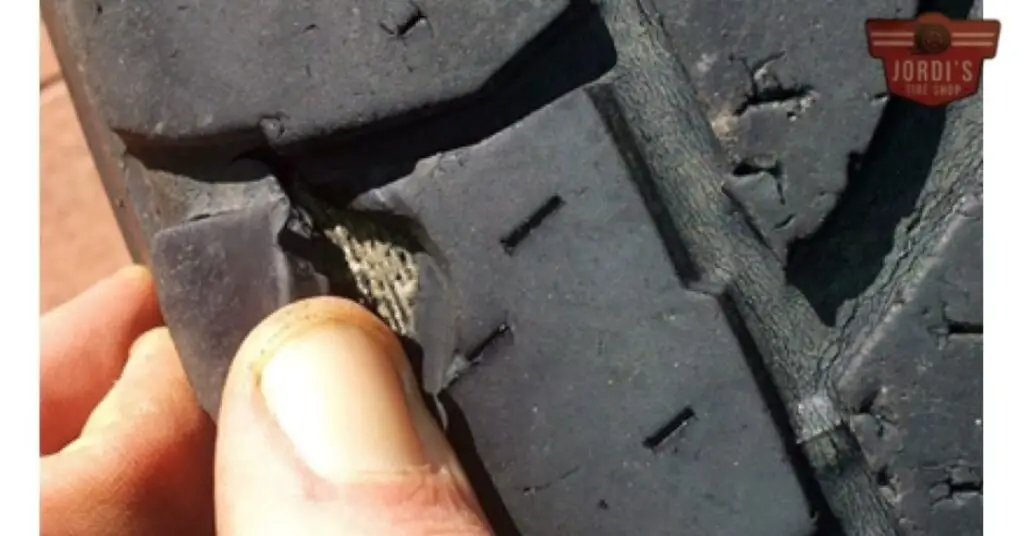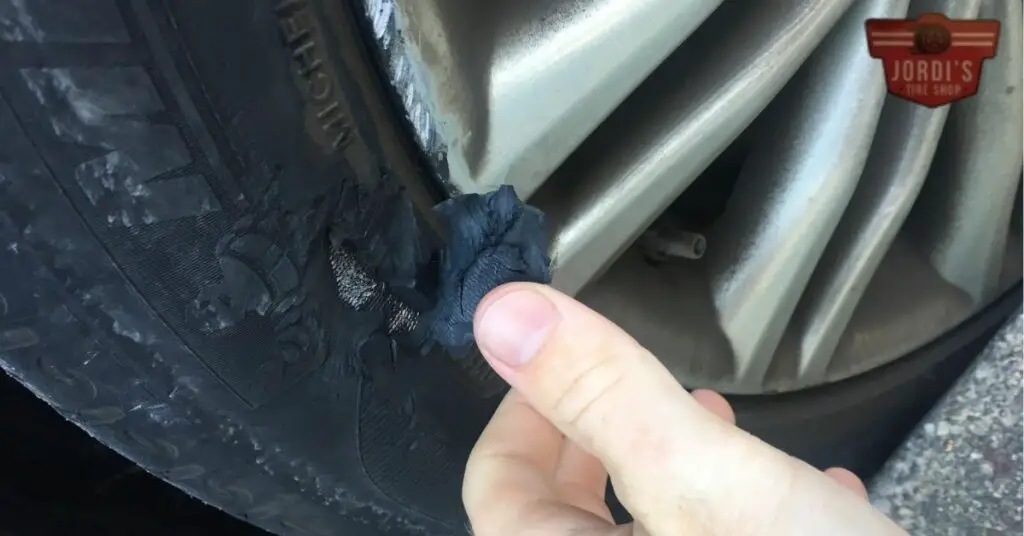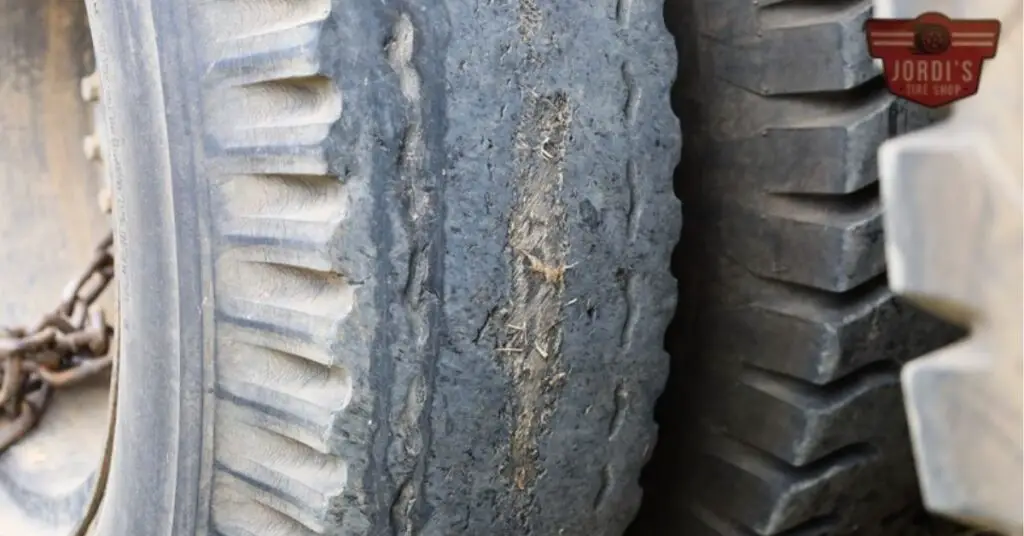Ever noticed the steel cords peeking out from your vehicle’s tires? That’s a sign you’re driving on borrowed time. Exposed cords are a red flag, signaling that your tires are screaming for a replacement. But how long can you push it?
Understanding Tires with Exposed Cords

In the journey of maintaining optimum vehicle performance, understanding the concept of exposed cords in tires is vital. It’s not just about knowing their appearance but also the causes and implications involved.
What are Exposed Cords in Tires
Exposed cords in tires, typically seen as metallic or fabric lines appearing through the worn surface, connote a severe state of tire wear. Originally hidden within the tire’s structure, these strands, made predominantly of steel or sometimes polyester, are key in providing tire strength. When surfaced on the tire, they present a clear indication that tire’s structural integrity is compromised, treading dangerously close to failure.
Causes behind the Exposure of Tire Cords
The exposure of tire cords usually is an outcome of worn down treads, which, in turn, results from continuous use or improper driving habits like aggressive driving. Overinflation and underinflation are potent culprits, leading to uneven wear and eventual exposure of tire cords. Poor alignment can cause similar wear patterns, gradually revealing the tire cords. Environmental factors such as road conditions, temperature fluctuations, and presence of sharp objects equally contribute to tire erosion, which, unchecked, may strip down the tire surface to its core structures – the cords.
The Impact of Exposed Cords on Tire Durability

Let’s investigate deeper into the implications of cord exposure on the longevity and safety of your tires.
Effects of Exposed Cords on Tire Lifespan
When cords become visible in your tires, the lifespan of the tire reduces drastically. Exposed cords mean that the tire is in its final stage of usability. One primary driver of this, particularly identified in driving on rough terrains or in extreme weather conditions, is tread wear. Optimal tread depth facilitates traction and stability while also preventing premature cord exposure. Exposed cords are often synonymous with compromised tire performance, not to mention signaling a severe state of tire wear. Once exposed, the cords’ fabric or metallic nature becomes susceptible to degradation from temperature, moisture, and abrasive road conditions. So, the tire’s structural integrity and functionality tend to decline progressively, accelerates tires’ wear-out rate.
Risks of Driving on Tires with Exposed Cords
There’s a important risk attached to continuing to operate your vehicle with tires that exhibit exposed cords. For starters, exposed cords present the danger of blowouts, especially at high speeds due the augmented pressure on the damaged area. More so, punctures become more likely as there’s a higher chance of sharp objects penetrating the inner tube. Also, the handling and control of your vehicle are significantly hampered, causing challenges in braking, accelerating, or maneuvering through corners. Most notable is the uncertainty it introduces – exposed cords are essentially a ticking time bomb, it’s uncertain how long till they fail. For your safety and those around you, it’s paramount that you replace tires with exposed cords as they are a potent accident catalyst.
How Long Do Tires with Exposed Cords Last

Exposed cord tires signify the final stage of tire usability, hinting at grave safety risks to consider. In this stage, there isn’t much longevity to anticipate as the tires stand on the brink of a potential failure.
Factors Influencing the Lifespan of Tires with Exposed Cords
The lifespan of tires with exposed cords typically hinges on several factors.
Driving Conditions: Harsh environments and rough terrains, with rocks, debris, and sharp objects, will further damage the exposed cords, hastening tire failure.
Vehicle Load: Carrying heavy loads exacerbates the stress on your tires, leading the exposed cords to deteriorate faster.
Driving Habits: Aggressive maneuvers, such as sharp turns and sudden braking, can lead to rapid cord wear and tear, shortening the lifespan of your tires.
Comparing Lifespan of Tires with And without Exposed Cords
Understanding the stark difference in lifespan between tires with exposed cords and those without is crucial.
A new tire, depending on its quality and usage conditions, may last anywhere from 20,000 to 60,000 miles. Regular maintenance such as rotation, alignment, and correct inflation, enhance this lifespan.
On the other hand, a tire with exposed cords is nearing its end. Mileage expectation should drop drastically. Aggressive driving, a heavy vehicle load, or poor road conditions could expedite a blowout. So, driving many miles with exposed cords isn’t safe, nor feasible.
Tips for Identifying and Dealing with Exposed Cords
Having exposed cords in your tires signals severe tire wear. Hence, recognizing the signs and dealing with the situation swiftly and adequately is crucial for your safety.
How to Identify Tires with Exposed Cords
Detecting exposed cords in a tire involves careful visual examination. Look for apparent changes on the tire’s surface. Exposed cords appear as metallic or fabric lines peeking through the tire’s worn surface. Besides, irregularities like bulges, cracks, or cuts could indicate severe wear leading to exposed cords. Reduced tread depth also serves as a telling sign, as tires with extremely worn treads often expose their steel cords.
Immediate Steps to Take If You Notice Exposed Cords
Upon spotting exposed cords, immediate action is necessary. First, limit the use of the vehicle to avoid further damage and potential accidents. Contact a trusted mechanic or tire professional for advice on the next step – in most cases, that would be tire replacement. Resist the temptation to continue driving for extended distances as the compromised structural integrity poses important safety risks, including blowouts and impaired vehicle handling. Invest in new tires promptly to ensure your safety and that of other road users.
Preventive Measures and Long-Term Solutions

Equipped with knowledge about tire cords exposure, it’s time now to investigate into preventing such occurrences and seeking credible answers.
Maintaining Tire Health to Prevent Cords Exposure
Practice proactive tire health maintenance to keep cords exposure at bay. Regular inspection stands as the first step. Those translucent metallic or fabric lines serve as tangible warnings, signaling excessive tire wear. Looking out for irregularities, such as bulges or cracks, equally matters in early detection.
Next, aim for appropriate tire inflation. Pressure checks every month can save your tires from unnecessary strain. Over-inflation hardens tires, making them more susceptible to damage, while under-inflation causes uneven wear, both leading to premature cords exposure.
Plus, align your tires periodically. Poor alignment triggers erratic tread wear patterns, speeding up the process of cords exposure. Considering road conditions and temperature fluctuations, a semi-annual inspection with your trusted mechanic promotes long-lasting tire health.
Driving habits also play a crucial role. Avoid aggressive maneuvers that can induce stress on your tires. A slow steady start, gentle cornering, and gradual braking reduce wear and tear, later delaying cord exposure.
When and Why to Replace Tires with Exposed Cords
Indisputably, exposed cords mark the end of a tire’s life. These worn-out tires, now susceptible to environmental degradation, possess a drastically reduced lifespan and compromise safety.
Driving conditions, vehicle load, and driving habits decisively impact the remaining life span of the tire. Harsh environments and heavy loads accelerate deterioration, while aggressive driving expedites wear. Maintain a keen eye on these factors as they’re the primary determinants for when you’ll need a tire change.
Refrain from pushing the limits too far, even though the temptation. Tires on the brink of failure endanger lives. Risks of driving on worn-out tires are serious. Increased likelihood of punctures, danger of blowouts, and impaired vehicle handling, puts you and others on the road at risk. Prioritize safety over distance. Even a short journey on exposed cords can spell disaster.
Replacing tires with exposed cords undoubtedly takes precedence. Find a reliable mechanic, invest in a new set of good-quality tires, and insist on regular check-ups and maintenance for ensuring safety on the road. Keep in mind, a proactive strategy can save you from potential hazards down the road.
Conclusion
You’ve now got a firm grasp on the lifespan of tires with exposed cords. They’re in their final stage of usability and aren’t safe for extended driving. Your safety, along with others on the road, is at risk due to the likelihood of tire blowouts and impaired vehicle handling. Make it a priority to replace these tires immediately and consult a trusted mechanic for this task.
Remember, prevention is key. Regular tire checks, proper inflation, and alignment can help avoid cord exposure. Drive sensibly to reduce tire stress and extend their life. When it comes to tires, investing in quality and maintenance pays off in the long run. Keep these points in mind to ensure a safe and smooth journey every time you hit the road.
What are exposed steel cords in vehicle tires?
Exposed steel cords in vehicle tires are the metallic or fabric lines that become visible through the worn surface of a tire. They indicate a severe state of tire wear and compromised structural integrity.
What causes the exposure of steel cords in tires?
Exposure of steel cords is caused by factors such as worn treads from extensive use, aggressive driving habits, improper tire inflation, poor alignment, and varying environmental elements like road conditions and temperature changes.
How does cord exposure affect tire durability and safety?
Once the cords are exposed, the tire’s lifespan significantly reduces, and it enters its final stage of usability. Exposed cords compromise tire performance and structure, making them vulnerable to degradation from environmental influences, increasing chances of blowouts, punctures, and impaired vehicle handling.
How long can tires with exposed cords last?
Tires with exposed cords are close to potential failure and have a severely limited lifespan. Factors like driving conditions, vehicle load, and driving habits affect their longevity. However, tires with exposed cords should not be driven for extended distances due to safety hazards.
What measures help identify and deal with exposed cords?
Signs of severe tire wear such as visible metallic/fabric lines, abnormalities like bulges or cracks, and reduced tread depth should be recognized promptly. If exposed cords are observed, limit vehicle use and consult a trusted mechanic for tire replacement.
What are the preventive measures for cord exposure?
Preventive measures include regular tire inspections, proper tire inflation, periodic alignment checks, and avoidance of aggressive driving habits. Immediate replacement of tires once cords are exposed is necessary to avoid serious safety risks. Prioritizing safety, seeking trustworthy mechanics, investing in quality tires, and regular maintenance ensure longer tire life.
Related Posts:
- Exposed Cords on Tires: How Long Can They Last Before Replacement?
- Mastering the Art of Driving: Unraveling the Meaning of ‘Depress Brake Pedal’
- Solving the Mystery: Why Are Your Car’s Driver Information Center Buttons Not Working?
- Decoding Harley Davidson Dash Warning Lights: A Complete Guide for Safe Rides
- Unveiling the Mystery: Understanding Your Kioti Tractor Warning Lights
- Decoding Forklift Warning Light Symbols: A Comprehensive Guide to Ensuring Warehouse Safety
- Deciphering Hamm Roller Warning Lights: Your Guide to Safe & Efficient Operation
- Unlocking the Power of Jeep Compass Screen Lines: A Comprehensive Guide
- Steer Clear: Discover the Troublesome 7.3 Powerstroke Years to Avoid
- Unraveling the Mystery: What Causes Grooves in Your Car’s Brake Rotors?

